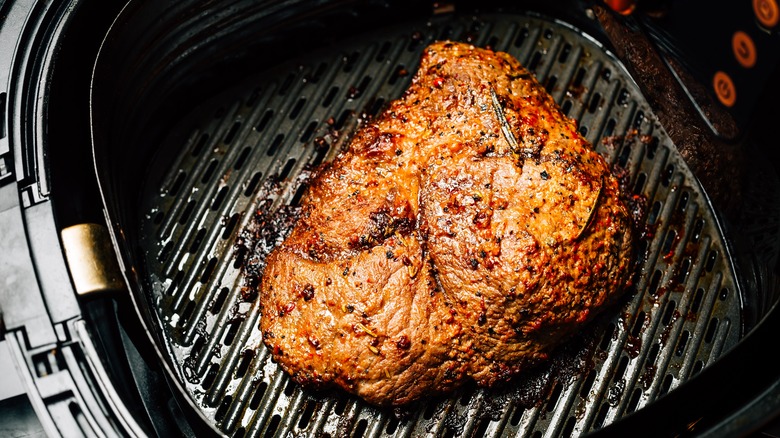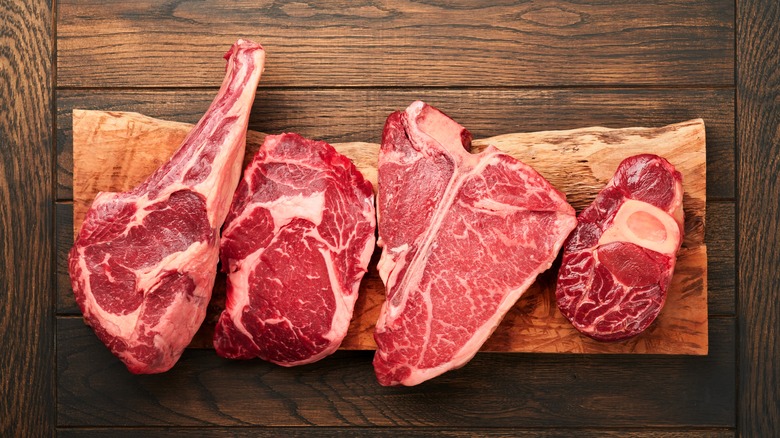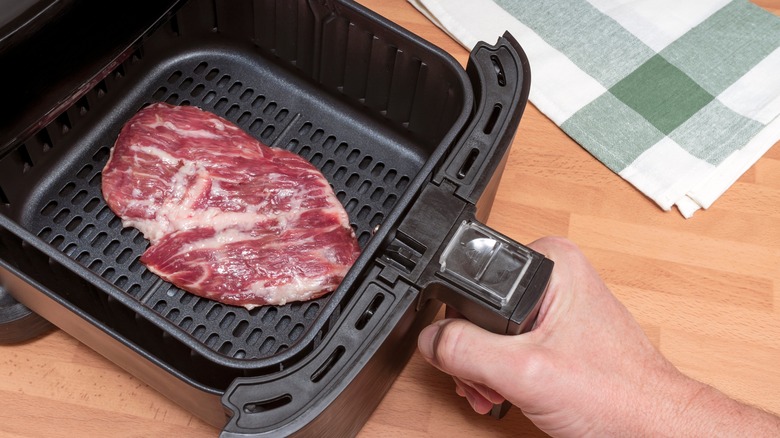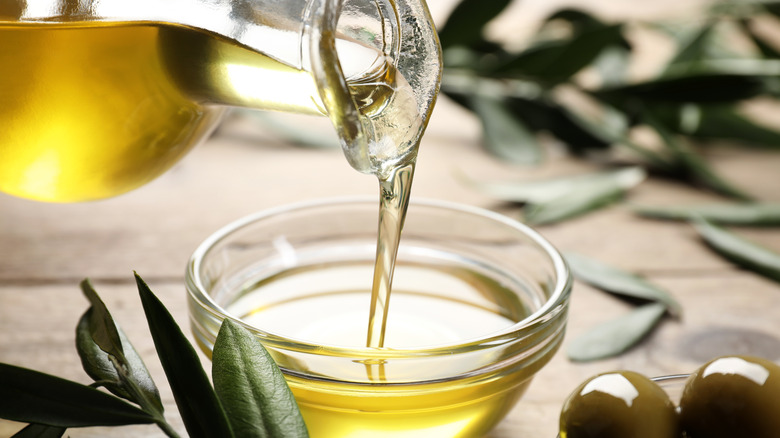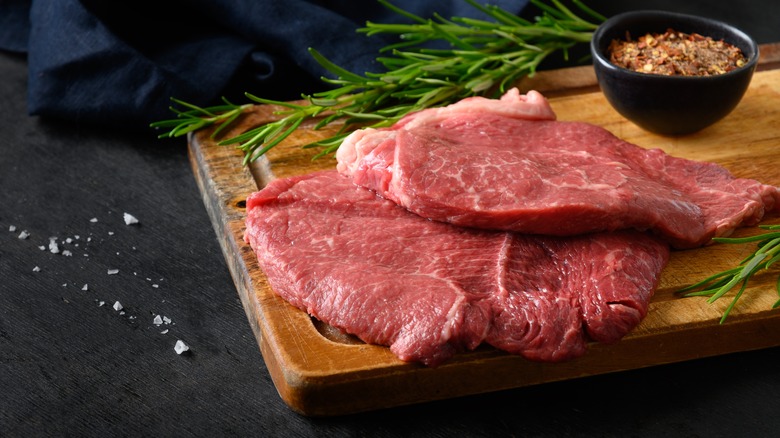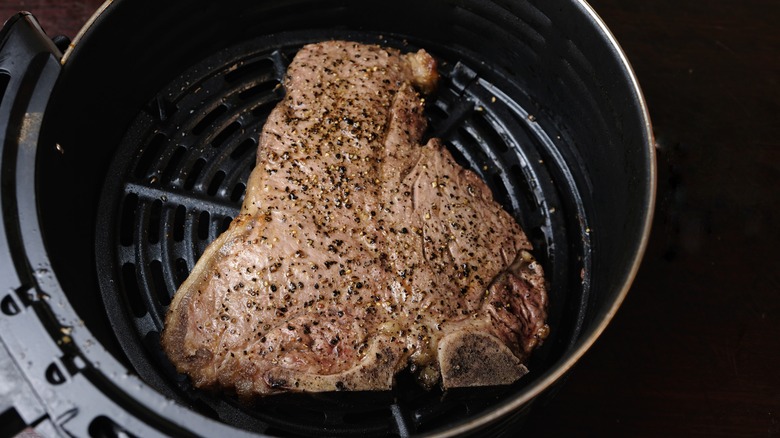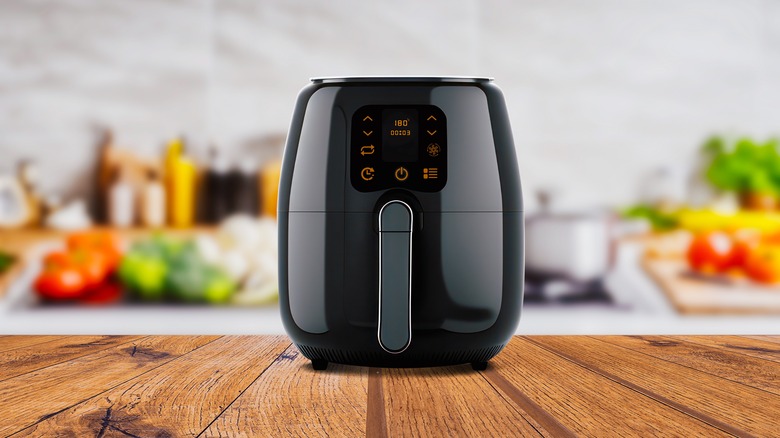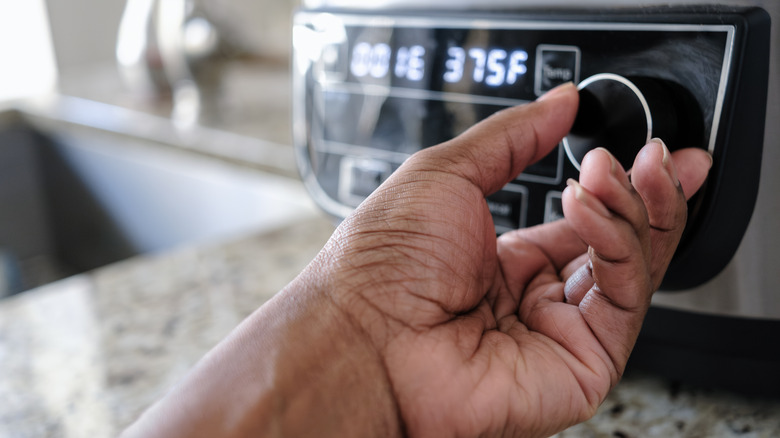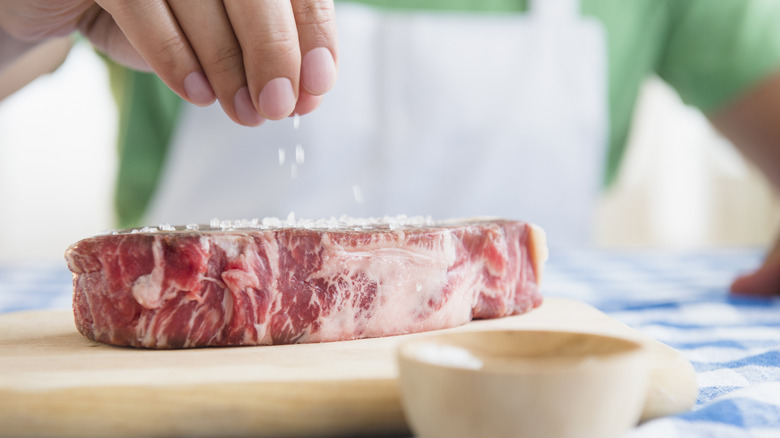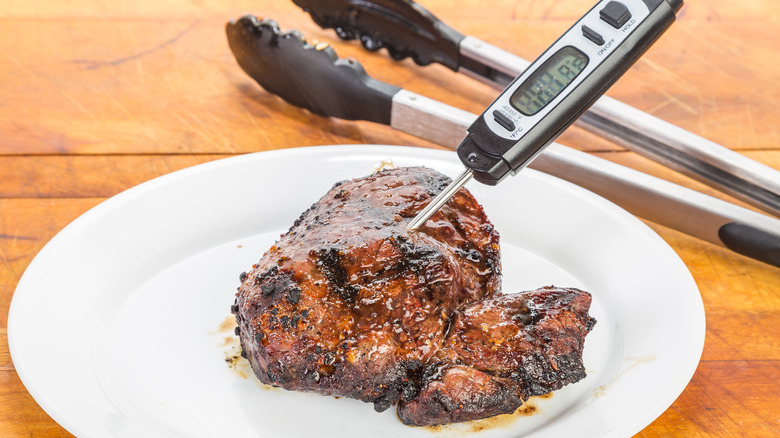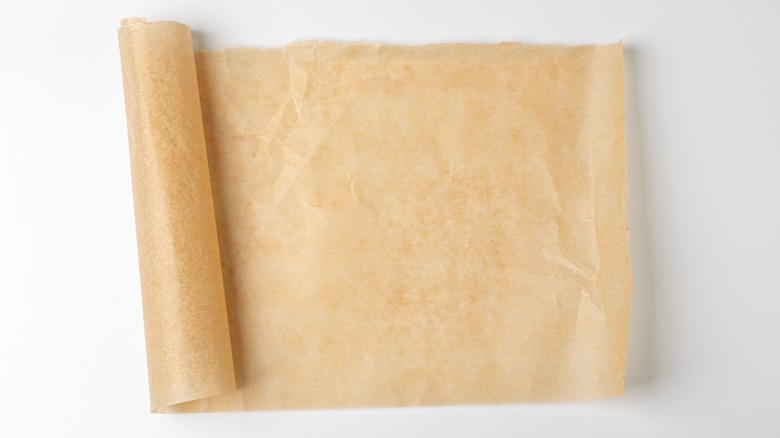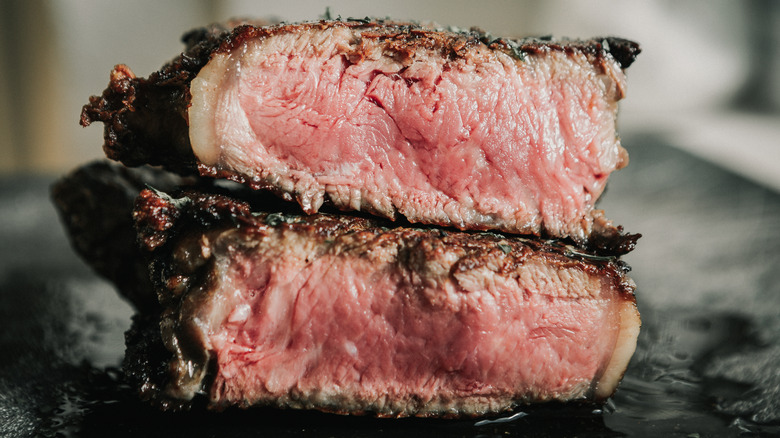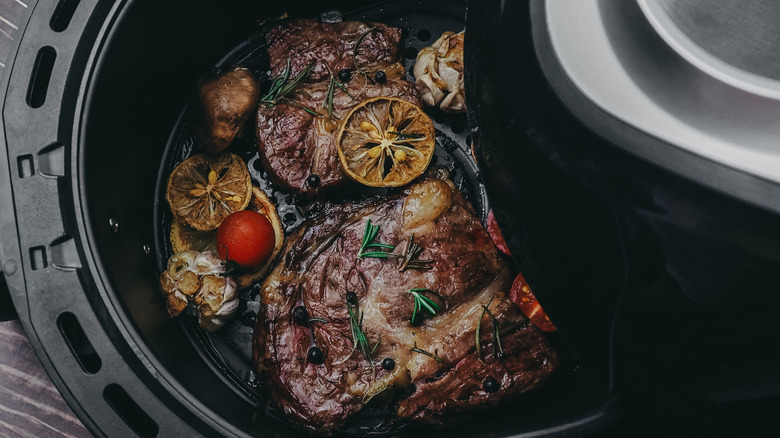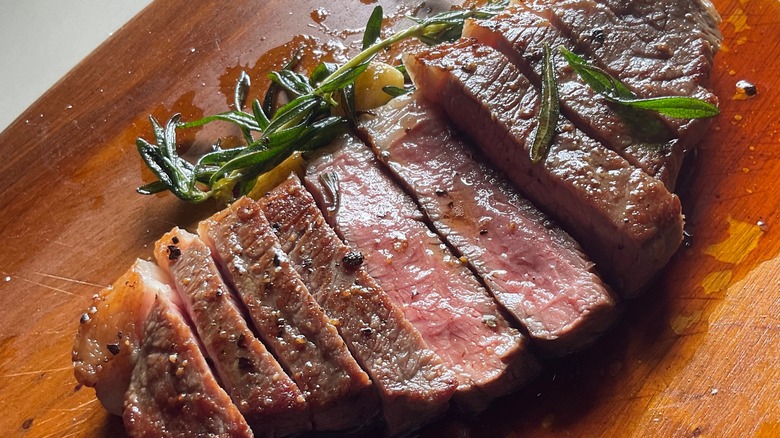14 Tips For The Perfect Air Fryer Steak
Steak in the air fryer? Yes, it's a thing — and a good one, too. Meat and air fryers are a perfect pairing, and using the appliance is a surefire way to get a juicy, well-cooked result (you can even cook frozen meat in your air fryer, if you want to). Despite this, some people get pretty nervous about placing their expensive cuts of steak in the air fryer, preferring instead to rely on the tried-and-tested method of frying it in a pan.
However, air frying steak can produce a result that's seared on the outside while still rare and juicy in the middle. The hot circulating air that air fryers rely on seals the meat rapidly and browns the outside without overcooking its interior. There are no fat splatters, no piping hot pans to wash up, and no smoke stinking out your kitchen.
Air frying steak isn't as simple as turning on your machine and hoping for the best, though. That's why we had to get an expert to weigh in. We asked David Rose, executive chef for Omaha Steaks, to give us his top tips for air fryer steak, and he shared his hard-won knowledge with us.
1. Start with the right cut of steak
You can have the best air fryer money can buy, but it's nothing without the right cut of steak. When air frying your steak (indeed, when cooking your steak in any method), you'll want to make sure you have the best cut you can afford. Luckily, you have a few choices to choose from.
"I recommend filet mignon, top sirloin, strip steak, or ribeye," says David Rose. These cuts all have a tenderness to them and are loaded with flavor, thanks to their fat marbling, which helps to distribute the juices through the meat. As well as being one of the best cuts of steak for a dinner party, filet mignon works especially well in an air fryer, with its thickness allowing it to remain rare while the outside browns. On the other hand, if you're looking for excellence on a budget, top sirloin strikes a perfect balance of flavor and affordability. Although it's slightly leaner than some other cuts, it's still a winner in the air fryer, provided that you don't overcook it.
2. Ensure your steak is as dry as possible
The beauty of air fryers is that they wick away the moisture from your food, allowing them to brown effectively. However, no air fryer is perfect — and when you're dealing with steak, you should help it out by ensuring it's as dry as possible. Drying your steak before seasoning allows it to develop a deep sear without having to evaporate the water on the surface first. It also ensures that your seasonings remain as intense as possible on the surface of the meat.
It's worth pointing out that this step isn't exclusive to air fryer cooking. The reason why you should pat your meat dry, no matter how you're cooking it, is so it get that deep-brown surface. To do this, simply pat it down thoroughly with paper towels, being sure to get the sides as well so that they can brown properly too. If you're using a bone-in cut, ensure that you're patting it down right around the bone itself and picking up any water that's pooled there. Once your steak is dry, check it to ensure that no bits of paper towel have peeled off onto the surface.
3. Use the right fat
Fat is an essential component in cooking steak, and in an air fryer, things are no different. While the appliance is famed for being able to cook things without too much fat, you'll still want some with your steak to ensure that it browns evenly on each side. You have to use the right one, though. "I recommend using olive oil when air frying steak," suggests David Rose. "Once your steak is thawed and pat dry with a paper towel, rub lightly with olive oil."
Olive oil is well-known for being a heart-healthy oil that has a nuanced, nutty flavor — but with steak, the reason we like it as much as David Rose is due to its smoke point. Olive oil's relatively high smoke point means that it can take the higher temperatures of an air fryer without breaking down. This is unlike some of the more popular fats that are paired with steak, like butter, which can quickly turn smoky and acrid when placed in an air fryer. You should also avoid using flavored oils, as these can just give your steak a strange taste and work against the flavor of your rub.
4. Temper your meat
Too many of us think that the air fryer is a magic appliance that can cook anything we pull out of the fridge perfectly. Well, when it comes to air frying steak, you may need to pull your meat out of the fridge a little earlier than you think. Tempering your steak (i.e., allowing it to come up to room temperature) is an essential step before air frying it. When you throw meat in an air fryer, it'll rapidly increase its outer layer and start to brown it instantly. The colder the inside is, the longer it'll take to cook through – and with steak, this can leave you with a piece of meat that's overcooked on the outside and too pink on its inside.
Don't think you have to leave your steak at room temperature for hours, though (and you probably won't want to, for food safety purposes). Simply pull the steak out around 30 minutes to an hour before you're ready to cook it. Bear in mind that the thicker your steak is, the longer it'll need to warm up. This is also true if you keep your refrigerator at an especially low temperature.
5. Avoid searing your steak beforehand
There's a lot of misinformation out there when it comes to whether or not you should sear a steak before you air fry it, with those in favor stating that it's the best way to get a deep-brown crust. However, it's just not necessary, according to David Rose. "Air frying steak is the ideal combination of the delicious sear from pan-searing and the ease of cooking steak in the oven," he says. Your air fryer may not be able to get that blackened edge that you'd get from throwing it in a pan at super-high heat, but it'll still brown beautifully.
The problem with searing steak before you air fry it is that you run the risk of overcooking it. Pan-searing steak begins the cooking process, with its interior temperature beginning to increase. Once it goes in the air fryer, it'll already be partially cooked and you run the risk of overcooking it. There's no need to sear it afterwards, either. While you might get away with timing it perfectly so that you develop a deeper crust without cooking it too much, you'll likely just turn your steak rubbery.
6. There's no need to marinate your steak — but you can give it a dry brine
Somewhere down the line, folks started marinating their top-end air fryer steaks, convinced that they'd imbue them with even more flavor. Unfortunately, this practice needs to end immediately. "Filet mignon, ribeye, top sirloin, New York strip, flat iron... these are the best, naturally tender steaks anywhere, and they need little more than light seasoning and heat," stresses David Rose. High-quality steaks get their flavor from their fat distribution and marbling, and by marinating them, you run the risk of both imbuing them with tastes they don't need and potentially breaking down their meat.
When it comes to dry brines, it's a different story. "I do recommend a dry brine to maximize the flavor and juiciness of your steak for as little as 30 minutes or up to 24 hours before cooking," says Rose. Dry brining involves adding salt to your steak beforehand, allowing its juices to seep out and then back into the meat to increase its tenderness. Steak marinades can also sometimes be useful for leaner cuts that lack natural flavor.
7. Ensure your air fryer is preheated
You don't always need to preheat your air fryer, but with steak it's a necessity. It's easy to assume that air fryers come up to temperature immediately, but they take a bit of time to do so. If you place your steak in it before it's preheated, the steak will start to slowly cook as the appliance warms up. This means that it will likely overcook slightly, and makes timings harder to keep track of.
Placing your steak in a cold air fryer and allowing it to heat up as the basket does also means that you miss out on an all-important additional sear. When you place your steak into the hot basket, you help it develop a little extra browning on its bottom side. Put it in cold and you won't get any of that added flavor. Luckily, preheating your air fryer takes virtually no time at all: Just set it to the temperature that you're going to cook your steak to, and let it warm up for a few minutes before throwing your meat in.
8. Adjust your cooking time for your desired doneness
All steaks cook slightly differently, and you'll have to adjust your timings accordingly. "Air fryer cooking times for steak can vary depending on the thickness of the meat and the appliance you use," says David Rose, so you'll have to tweak your timings depending on both the size and to what level of doneness you want it to be cooked.
Luckily, while steaks all cook at slightly different times, they don't vary too drastically. For a filet mignon steak weighing in at 5 to 6 ounces, Rose says you should aim to cook it for between 10 to 14 minutes. A top sirloin weighing roughly the same amount will require the same amount of time, with the shorter end of the timings resulting in a rare steak, and the longer end producing a well-done piece of meat. Interestingly, strip steaks should be cooked for a slightly shorter length of time (around 10 to 12 minutes) for cuts weighing in at 8 to 10 ounces, according to Rose. Importantly, too, if your steaks are especially round or chunky, it might be worth considering adding an extra minute to their timings to ensure that they cook to their center.
9. Add salt before, not after
Air fryer steak without salt is a pretty disappointing affair, but when it is added it is something a lot of people typically get wrong. Rather than sprinkle it on after, you should always do it beforehand. "I recommend seasoning liberally right after coating your steak with oil," says David Rose. A lot of people think that this will draw moisture out of the steak, making it dry — and while it may pull water from the meat, that water will then be re-absorbed, seasoning your steak from within.
This doesn't just make your steak tastier, though. Salting your steak beforehand also makes the meat's surface slightly drier, which helps it brown more effectively. For the best results in your air fryer, you should pat salt all over your steak, including its sides. Unlike pan-fried steak, air fried steak comes into continual contact with heat as it cooks, and its sides will usually cook at the same rate as its broader parts.
As for when you add your pepper — that's a slightly different story, and dependent on your preferences. Because pepper won't have any significant effect on how your steak browns, you can add it before or after. Adding it before will cook the pepper slightly, giving you a deeper, more charred flavor, whereas adding it after will keep its flavor fresher and more citrusy.
10. Grab a meat thermometer
A lot of people don't bother with meat thermometers when cooking steak — and honestly, we get it. These things can feel like an extravagance, and puncturing your steak with a sharp probe doesn't exactly improve its visual appearance. When air frying steak, however, using a meat thermometer is the best way to ensure that you've cooked it to perfection. Meat thermometers give you the most accurate read of your steak's interior temperature, which will tell you whether it's rare, medium-rare, or well-done. Relying on timings alone to achieve these is somewhat of an imperfect science, as all air fryers, and all steaks, are built differently.
David Rose points out that for a rare steak, you should look for a read of 120 to 130 degrees F in the thickest part of the meat. Medium-rare steaks will need to be a temperature of 130 to 140 degrees, while medium steaks sit in the 140- to 150-degree range. As for well-done steaks, Rose says you should be looking for a reading of 160 to 170 degrees F.
11. Don't line your air fryer with parchment paper
Air fryers are renowned for their ability to produce meals with minimal mess, and a lot of people like to line the baskets with parchment paper or foil to further reduce any splatters or drips. When it comes to steak, though, you should leave these out of your machine. When you use parchment paper (which is different from wax paper) to cook steak, you ruin the air fryer's ability to circulate air around the meat fully. As a result, they just don't brown as effectively as they should.
Placing parchment paper in your air fryer basket also prevents any moisture released from the steak dripping off of it. While this may be useful for your cleanup operation afterward, this moisture can cause your steak to cook in its own steam, and may leave it water-logged and flabby. Plus, if you put parchment paper down, you'll miss out on that delightful sear that develops on your meat when you place it on the basket's hot metal. So, skip the lining and put your meat straight in. You may have to spend an extra minute or two cleaning up after, but honestly, it's worth it.
12. Always flip your steaks
Most air fryer recipes advise that you flip your food halfway through the cooking process, and with steaks, things are no different. The reason you flip your steaks in an air fryer is exactly the same reason you flip them in a pan: access to heat. While air fryers are great at ensuring that heat envelops your food, the fact of the matter is that the bottom side of your steak will never get as warm as the top side, which is constantly exposed to hot air.
All of this, of course, helps browning. "Flipping steak halfway through cooking time ensures a crispy exterior on both sides," says David Rose. Try to aim your steak flipping to coincide with the exact halfway point of the cooking process; it could be helpful to blast the steak in two distinct sessions to ensure that you don't forget and lose track. Remember to use tongs to flip your steaks, too — they'll be hot, y'all — and try not to jiggle them about too much as you flip them, to avoid scraping off any of your seasonings.
13. Never crowd your steaks in the air fryer
Most air fryers are pretty small, making them the perfect appliance for cooking meals that cater to one or two people. However, if you're planning on cooking big, juicy steaks, even just two of them laid side-by-side can test the limits of your air fryer basket. Whatever you do, don't be tempted to shove them in and hope for the best. If you do this, you'll limit the ability of your air fryer to pump its air around the steak and cook it properly.
So, keep them apart. "Make sure to leave 1 inch of space between each steak," says David Rose. "This ensures adequate room in the air fryer for the air to circulate for a nice, crispy crust on all sides." Make sure your steaks are lying fully flat and not bunched up to make more room, as doing this may cause them to cook unevenly. You should also completely avoid the temptation to stack steaks on top of each other: It's not just horizontal space that's needed between the steaks, it's vertical space too. If you just can't fit the steaks in together with enough space between them, cook them one at a time and allow them to rest while the others are cooking.
14. Make sure you're resting your steak
Resting your steak is one of the most underappreciated steps in cooking it — and we get why. After all, most people just want to chow down as soon as their food is cooked, right? However, if you want a moist, tender, flavorful steak, you should always give it some time after you air fry it. "Always rest your steak for 5 to 10 minutes before slicing for a more tender, juicier bite," stresses David Rose. When you rest meat, all of those muscle fibers that have tightened up during the cooking process (forcing out moisture as they do) relax, allowing the steak to reabsorb its juices.
Crucially, though, you need to follow a few key steps to rest your meat properly. Make sure it is removed from the basket and placed in a location with no heat source; if you leave it in the basket, the leftover heat will continue to cook it. Additionally, David Rose points out that the residual heat will carry over into the meat itself, and it'll continue to firm up even once away from the air fryer. As a result, ensure that you're removing it when it's roughly 5 degrees F below your desired temperature. Additionally, if you want your meat to remain crispy, you should probably think twice about resting it under foil, which will just trap steam around your steak.
